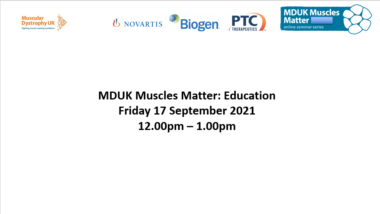Inclusive education for children with muscle wasting conditions: a guide for schools and parents
Together with a working group comprised of health, education and care professionals, parents, and staff from specialist voluntary organisations, we have produced a free, comprehensive guide for schools and parents.
We know that for children with a muscle wasting or weakening condition to thrive at school, a strong partnership between the school and the family is essential. This guide helps to provide the basis for shared understanding and suggests effective strategies to apply in the classroom.
Who is the guide for?
The guide is for schools, special educational needs advisors, teachers and educational support assistants who have children in their schools with muscle wasting or weakening conditions. The guidance is also helpful for parents who are working in partnership with their child’s school to provide the best possible educational experience for their child.
What does the guide cover?
The guide consists of 17 chapters, and covers:
- General information (diagnosis, muscle wasting conditions and key issues for the conditions)
- Access to schools and the curriculum (from early years setting to key stages 1 – 4)
- Working together – roles and responsibilities (education guidelines and working with parents and the child)
- Social, emotional and psychological support
- Health issues (healthcare plans, medical emergency, staying healthy and more)
- Environmental considerations (access and evacuation, equipment and adaptations to the school)
- Educational and school policies (school’s response to SEN, identifying SEN, funding SEN and more)
- Safer moving and handling
- Extended schools’ provision (partnership working, hospital schooling, respite/hospice care)
- Transition (planning and making choices)
- Physical education (PE)
- Managing playtime or break time
- Preparation for a school residential visit
- Information and communication technology (ICT)
- What to do if you are being bullied
- Exercise and diet
- Resources list and glossary
This document is full of so much useful information for both parents and schools. It covers a range of topics which we have come across on a regular basis with our students who have MD [muscular dystrophy]. The guide is full of important links to agencies that are there to help with every aspect of care, without bombarding students and parents with too much information in one go. Students and their families need to know there is so much support that they can easily access; this guide does that.
Download the free guide here.
